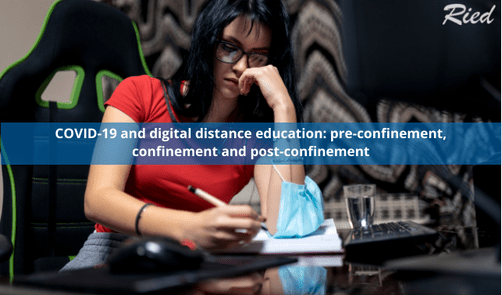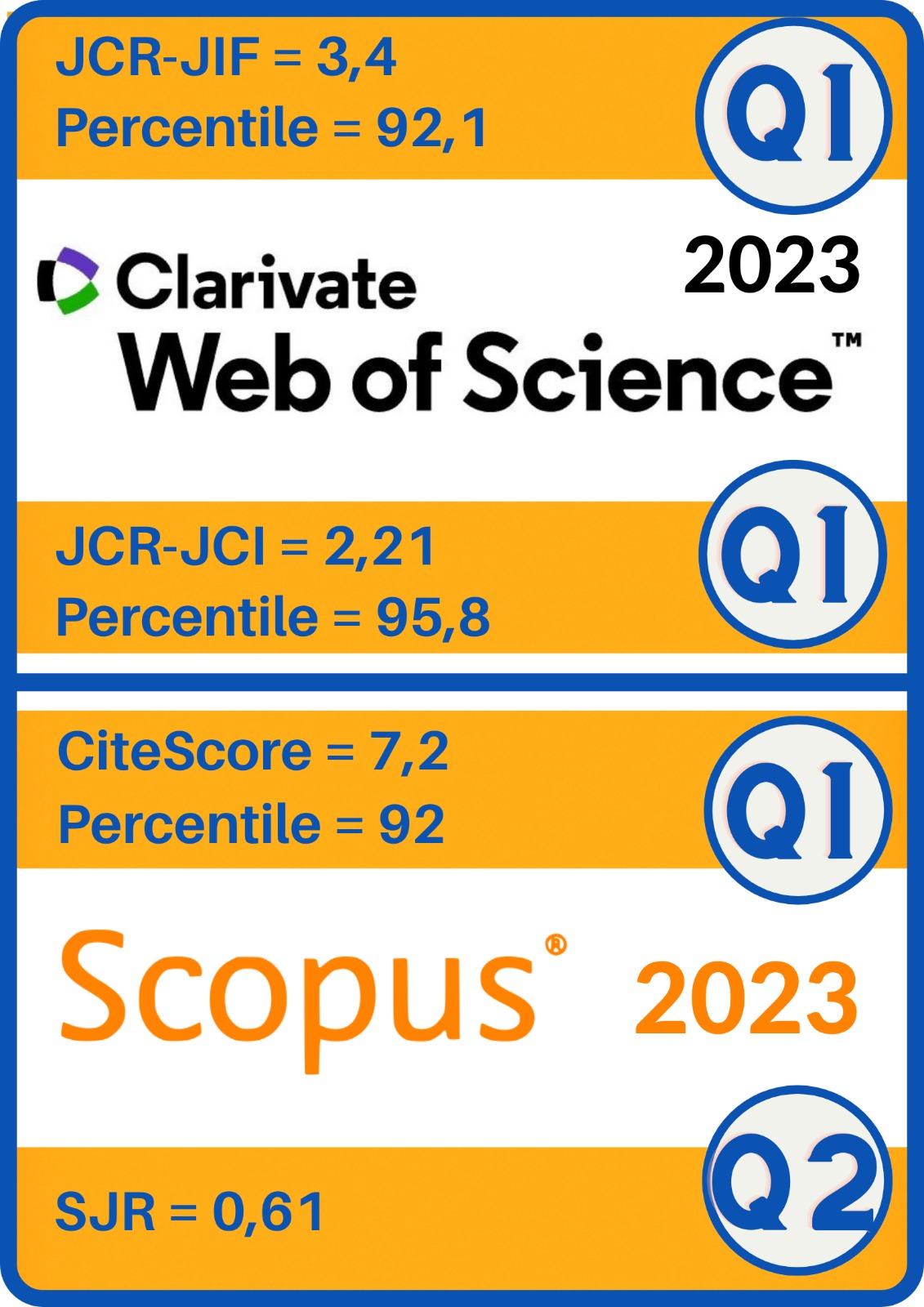COVID-19 y educación a distancia digital: preconfinamiento, confinamiento y posconfinamiento
DOI:
https://doi.org/10.5944/ried.24.1.28080Palabras clave:
COVID-19, educación a distancia, confinamiento, e-Learning, blended-learning, aprendizaje híbrido, combinado, mixto, flexibleResumen
La pandemia COVID-19 ha venido generando cambios y disrupciones en amplios sectores de la actividad humana. La educación ha sido uno de los más afectados debido a la imposición administrativa del cierre total de los centros educativos en gran parte de los países del mundo. La modalidad de educación a distancia, fundamentalmente en soporte digital, vino a ofrecer soluciones de emergencia a dicha crisis. En este trabajo se lleva a cabo una reflexión sobre las percepciones previas al COVID-19 relativas a esta modalidad educativa. Posteriormente se aportan ideas sobre la forma en que se acometió mayoritariamente la respuesta educativa al confinamiento a través de una educación de emergencia en remoto que se alejaba considerablemente de lo apropiado en diseños y desarrollos de una educación a distancia de calidad. Fueron muchos los errores cometidos y, por tanto, demasiadas las percepciones negativas por parte de muchos estudiantes, familias y docentes, bastantes de estos últimos ya reacios previamente a estos formatos más novedosos. Finalmente se aborda en el artículo la problemática más reciente, relativa a los tiempos de posconfinamiento, en los que no se prevé que en los centros presenciales todos los estudiantes puedan acudir a las aulas físicas en el mismo espacio y tiempo. Se ofrecen sugerencias sobre cómo abordar esta problemática a través de soluciones de hibridación, de una enseñanza y aprendizaje mixtos, combinados o, mejor, integrados y flexibles.
ARTÍCULO COMPLETO:
https://revistas.uned.es/index.php/ried/article/view/28080/22024
Descargas
Citas
Bao, W. (2020). COVID ‐19 y la enseñanza en línea en la educación superior: un estudio de caso de la Universidad de Pekín. Human Behavior and Emerging Technologies, 2(2), 113-115. https://doi.org/10.1002/hbe2.191
Beatty, B. (2007). Transitioning to an Online World: Using HyFlex Courses to Bridge the Gap. In C. Montgomerie y J. Seale (Eds.), Proceedings of ED-MEDIA 2007--World Conference on Educational Multimedia, Hypermedia & Telecommunications (pp. 2701-2706). Vancouver. https://www.learntechlib.org/primary/p/25752/
Beatty, B. J. (2019). Hybrid-Flexible Course Design. Implementing studentdirected hybrid classes. Provo, Utah: EdTech Books.
Dreesen, T., Akseer, S., Brossard, M., Dewan, P., Giraldo, J. P., Kamei, A., Mizunoya, S., y Ortiz, S. (2020). Promising practices for equitable remote learning Emerging lessons from COVID-19 education responses in 127 countries. Innocenti Research Brief. UNICEF. https://cutt.ly/ufffokG
Fox, K., Bryant, G., Lin, N., y Srinivasa, N. (2020). Time for Class – COVID-19 Edition Part 1: A National Survey of Faculty during COVID-19. Tyton Partners and Every Learner Everywhere, July 8, 32 pp. https://www.everylearnereverywhere.org/resources/time-for-class-covid-19-edition/
Hart, J. (2020). Top 200 Tools for Learning 2020, https://www.toptools4learning.com/
Hodges, C., Moore, S., Lockee, B., Trust, T., y Bond, A. (2020). La diferencia entre la enseñanza remota de emergencia y el aprendizaje en línea. Educause Review. https://er.educause.edu/articles/2020/3/the-difference-between-emergency-remote-teaching-and-online-learning
IESALC-UNESCO (2020). El coronavirus-19 y la educación superior: impacto y recomendaciones. https://cutt.ly/xdHJuhK
Jandrić P., Knox J., Besley T., Ryberg T., Suoranta J., y Hayes S. (2018). Postdigital science and education. Educational Philosophy and Theory, 50(10): 893–899. https://doi.org/10.1080/00131857.2018.1454000
Johnson, N., Veletsianos, G., y Seaman, J. (2020). U.S. Faculty and Administrators’ Experiences and Approaches in the Early Weeks of the COVID-19 Pandemic. Online Learning, 24(2). https://doi.org/10.24059/olj.v24i2.2285
Lozano-Díaz, A., Fernández-Prados, J. S., Figueredo Canosa, V., y Martínez Martínez, A. M. (2020). Impactos del confinamiento por el COVID-19 entre universitarios: Satisfacción Vital, Resiliencia y Capital Social Online, International Journal of Sociology of Education, Special Issue: COVID-19 Crisis and Socioeducative Inequalities and Strategies to Overcome them, 79-104. https://doi.org/10.17583/rise.2020.5925
Lozano, J. C., Cooper, E., y Soto, A. (2020). 5 Trends In VR Training Solutions To Elevate Your Blended Learning Program. eLearning Industry. https://cutt.ly/lfrpCqj
Miller, J., Risser, M., Griffiths, R. (2013). Student Choice, Instructor Flexibility: Moving Beyond the Blended Instructional Model. Issues and Trends in Educational Technology, 1(1), 8-24. University of Arizona Libraries. https://www.learntechlib.org/p/129818/
Naffi, N. (2020). Disruption in and by Centres for Teaching and Learning During the COVID-19 Pandemic: Leading the Future of Higher: L’Observatoire Internationale sur les Impacts Sociétaux de l’IA et du Numerique and the Government of Québec, https://cutt.ly/6fQZibh
Odriozola, P., Planchuelo, A., Irurtia, M. J., de Luis, R. (2020). Psychological effects of the COVID-19 outbreak and lockdown among students and workers of a Spanish university. Psychiatry Research, 290. https://doi.org/10.1016/j.psychres.2020.113108
Pedró, F. (2020). COVID-19 y educación superior en América Latina y el Caribe: efectos, impactos y recomendaciones políticas. Análisis Carolina, https://cutt.ly/sfytfUZ. https://doi.org/10.33960/AC_36.2020
Procter, C. T. (2003). Blended learning in practice. Education in a Changing Environment conference, (September 2003) Salford. http://usir.salford.ac.uk/id/eprint/27428/
Research and Markets (2019). Online Education Market & Global Forecast, by End User, Learning Mode (Self-Paced, Instructor Led), Technology, Country, Company. https://cutt.ly/QdHHPcI
Reich, J. (2020). Failure to Disrupt. Why Technology Alone Can’t Transform Education. Harvard University Press.
Singh V., y Thurman A. (2019). How many ways can we define online learning? A systematic literature review of definitions of online learning (1988-2018). American Journal of Distance Education, 33(4), 289–306. https://doi.org/10.1080/08923647.2019.1663082
Stein, J., y Graham, C. R. (2020). Essentials for blended learning: A standards-based guide. Routledge. https://doi.org/10.4324/9781351043991
Tucker, C. (2020). The Concurrent Classroom: Using Blended Learning Models to Teach Students In-person and Online Simultaneously. @Catlin Tucker. https://catlintucker.com/2020/09/concurrent-classroom-blended-learning-models/
u-Multirank (2020). About 60% of universities reported online learning provisions in their strategic planning pre-COVID-19, but only few appeared to be prepared for a quick shift to full online programmes. https://cutt.ly/VfGDArk
UN (2020a). Policy Brief: Education during COVID-19 and beyond (August 2020). United Nations. https://cutt.ly/bdHJEhX
UN (2020b). Policy Brief: The World of Work and COVID-19 (June, 2020). United Nations. https://cutt.ly/6fpDKHF
UNESCO (2020). Startling digital divides in distance learning emerge. https://cutt.ly/adH2SRS.
Wiederhold, B.K. (2020). Connecting Through Technology During the Coronavirus Disease 2019 Pandemic: Avoiding ‘‘Zoom Fatigue’’. Cyberpsychology, Behavior, and Social Networking, 23(7). https://doi.org/10.1089/cyber.2020.29188.bkw
World Bank (2020). How countries are using edtech (including online learning, radio, television, texting) to support access to remote learning during the COVID-19 pandemic. World Bank. https://cutt.ly/ZfuND7b.
World Economic Forum, (2020). 3 ways the coronavirus pandemic could reshape education. https://url2.cl/N3klw.
Zhu, X., y Liu, J. (2020). Education in and After Covid-19: Immediate Responses and Long-Term Visions. Postdigital Science and Education, 1-5. https://doi.org/10.1007/s42438-020-00126-3

Descargas
Publicado
Cómo citar
Número
Sección
Licencia
Derechos de autor 2020 RIED. Revista Iberoamericana de Educación a Distancia

Esta obra está bajo una licencia internacional Creative Commons Atribución 4.0.
Las obras que se publican en esta revista están sujetos a los siguientes términos:
1. Los autores ceden de forma no exclusiva los derechos de explotación de los trabajos aceptados para su publicación en "RIED. Revista Iberoamericana de Educación a Distancia," y garantizan a la revista el derecho a ser la primera en publicar ese trabajo, igualmente, permiten a la revista distribuir obras publicadas bajo la licencia indicada en el punto 2.
2. Las obras se publican en la edición electrónica de la revista bajo una licencia Creative Commons Reconocimiento 4.0 Internacional (CC BY 4.0). Se permite copiar y redistribuir el material en cualquier medio o formato, adaptar, remezclar, transformar y crear a partir del material para cualquier finalidad, incluso comercial. Debe reconocer adecuadamente la autoría, proporcionar un enlace a la licencia e indicar si se han realizado cambios.
3. Condiciones de auto-archivo. Se permite e incentiva a los autores a difundir electrónicamente la versión OnlineFirst (versión evaluada y aceptada para su publicación) de su obra antes de su publicación definitiva, siempre con referencia a su publicación en RIED, ya que favorece su circulación y difusión antes y así propiciar un posible aumento de su citación y alcance entre la comunidad académica. Color RoMEO: verde.







